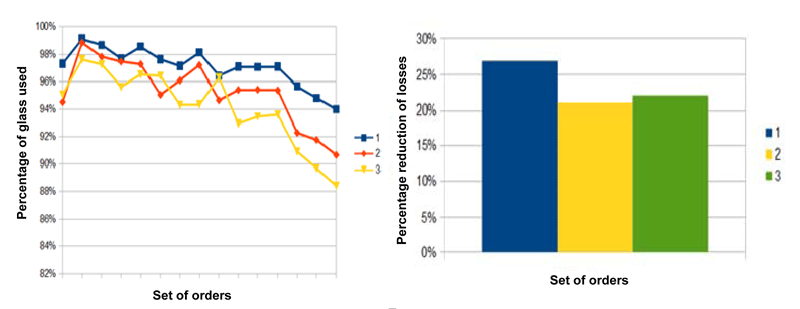by José Francisco García Cantos, Manuel Peinado, Miguel A. Salido and Federico Barber (AI2-UPV)
Metaheuristic techniques can help to optimise various industrial processes. These techniques can be used, for example, to help plan cutting processes in continuous float glass manufacturing, resulting in reduced losses due to material defects.
The processes within industry have been evolving over the years. In the early days, workers were necessary to run the machines, but today most of the work is being automated, resulting in cost savings but also creating difficult optimisation problems. This can be illustrated with the problem of cutting stock in general and glassmaking in particular. In this manufacturing process, cuts are generated automatically, but culling due to existing defects should be minimised.
Float glass is a sheet of glass made by decanting molten glass on a bed of molten metal, typically tin. The manufacturing process starts with a mixture of materials in an oven at a high temperature (Figure 1). The molten mixture passes through a pool of liquid tin where the glass surface is formed. An array of scanners detects the type and position of defects that may appear in the manufacturing process. According to the production orders (number, size and quality of glass sheets) and found defects, cut planning is carried out ensuring the required quality of each order and minimising losses of glass (cullet).These losses occur when, due to existing defects in a zone of the glass ribbon, the required quality cannot be achieved in any order. After cutting, glass sheets are allocated to a loader, so there cannot be more orders in production than available loaders.
![Figure 1: Flat glass production process. For more details see [L1].](/images/stories/EN107/barber1.jpg)
Figure 1: Flat glass production process. For more details see [L1].
The project developed at the Instituto Universitario de Automática e Informática Industrial (AI2) of the Universitat Politècnica de València (UPV) in the framework of the TETRACOM action “OPTIGLASS: Artificial intelligence-based techniques for optimizing the continuous glass cutting problems” aims to optimise the cutting process planning in order to reduce losses [1]. The action was realised in collaboration with AGC Glass Europe, one of the most important global glass manufacturers.
The company was already planning cuts automatically, although the cut planning process was not fully optimised. A greedy algorithm that chooses the highest priority order that meets the quality requirements to produce a glass sheet was applied. Therefore, if no order fulfilled the quality requirements, a loss was generated. Consequently, this method allows glass to be produced following a priority, but it does not minimise cullet.
Metaheuristic techniques are higher-level searching procedures, which guide subordinate heuristics, allowing combining exploring and exploiting of the search space in combinatorial optimization problems and finding efficiently near-optimal solutions. Our metaheuristic-based method starts by obtaining all cutting patterns that exist every 16 metres (the distance between the guillotine and the scanners) choosing the production of the sheets that generates less cullet. Afterwards, it searches for the best pattern, taking into account the objective of reducing cullet at an affordable computational cost (Figure 2).
![Figure 2: Cut planning process [L1].](/images/stories/EN107/barber2.png)
Figure 2: Cut planning process [L1].
The second problem was to decide the best sequence of orders to be introduced in the system, since the maximum number of simultaneous orders is limited by the number of available loaders. This sequence was decided by production experts, but this problem can be also automated. The planning process cut was complemented by another heuristic process for determining the best set of orders, which is the best combination of required quality and size that minimises cullet, according to the defects found in the glass ribbon.
Once we had solved the optimisation problems encountered in flat glass manufacturing, a cutting glass simulator was developed. In this simulator, a series of orders are introduced, as well as randomly generated defects according to historical data of the company. The simulator obtains the best cutting positions and the insertion of new orders in the system (Figure 3).
![Figure 3: Web-based simulator [L2].](/images/stories/EN107/barber3.png)
Figure 3: Web-based simulator [L2].
A set of tests of the developed system were carried out in different scenarios including different sets of orders and various glass configurations and defects. In these tests, over 90% of glass was used (and in most cases over 95%) with the new planning system, therefore losses are low, below 10% (Figure 4). As figures show, a reduction of losses greater than 20% can be obtained with respect to a non-optimised planning.

Figure 4: Ribbon glass exploitation depending on combination of orders and obtained improvement.
The project demonstrates the applicability of optimisation systems for material cost savings, as well as a clear energy saving in manufacturing processes of flat glass. As recognised by the company management: “The project has been very profitable. The optimisation reduces losses and increases the competitiveness of the company in the market. This kind of relationship and technology transfer should be encouraged” [L3].
Links:
[L1] http://www.metroglass.co.nz/catalogue/009.aspx
[L2] http://gps.blogs.upv.es/software-transferencia/
[L3] http://www.tetracom.eu/impact
Reference:
[1] “OPTIGLASS: Artificial Intelligence-based techniques for optimizing the continuous Glass Cutting Problems”. FP7-ICT-2013-10- Nº 609491, TEchnology TRAnsfer in COMputing systems, TETRACOM-U.E.
Please contact:
Federico Barber, Ai2, UPV, Spain











